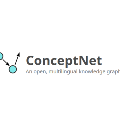In many applications, it is important to characterize the way in which two concepts are semantically related. Knowledge graphs such as ConceptNet provide a rich source of information for such characterizations by encoding relations between concepts as edges in a graph. When two concepts are not directly connected by an edge, their relationship can still be described in terms of the paths that connect them. Unfortunately, many of these paths are uninformative and noisy, which means that the success of applications that use such path features crucially relies on their ability to select high-quality paths. In existing applications, this path selection process is based on relatively simple heuristics. In this paper we instead propose to learn to predict path quality from crowdsourced human assessments. Since we are interested in a generic task-independent notion of quality, we simply ask human participants to rank paths according to their subjective assessment of the paths' naturalness, without attempting to define naturalness or steering the participants towards particular indicators of quality. We show that a neural network model trained on these assessments is able to predict human judgments on unseen paths with near optimal performance. Most notably, we find that the resulting path selection method is substantially better than the current heuristic approaches at identifying meaningful paths.
翻译:在许多应用中,必须说明两个概念的内在关联方式。 概念网等知识图形为这种定性提供了丰富的信息来源。 概念网等知识图形为这种定性提供了丰富的信息来源,将概念之间的关系编码成图表中的边缘。 当两个概念之间没有直接的边缘联系时,它们之间的关系仍然可以以连接它们的途径来描述。 不幸的是,许多这些路径都是不提供信息和吵闹的,这意味着,使用这些路径的应用程序的成功与否关键取决于它们选择高质量路径的能力。 在现有的应用中,这个路径选择过程以相对简单的超自然学为基础。 在本文中,我们提议学习从众包人类评估中预测路径质量。由于我们对一个通用的、任务独立的质量概念感兴趣,我们只是要求人类参与者根据他们对路径自然特性的主观评估来排列路径,而没有试图界定自然特性或引导参与者达到特定的质量指标。 我们表明,在这些评估中培训的神经网络模型能够预测人类对视视视路的判断,并近乎最佳性能。 特别是,我们发现, 由此得出的路径选择方法比当前的道路要好得多。




